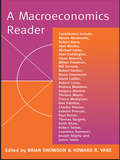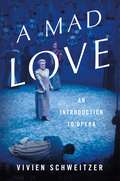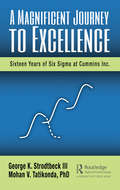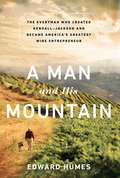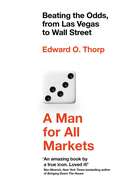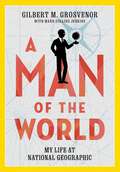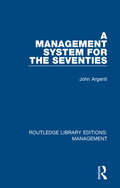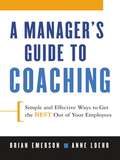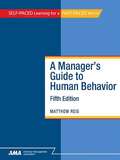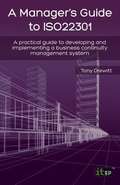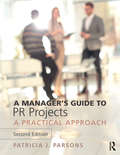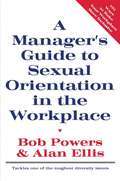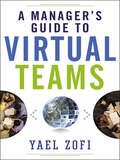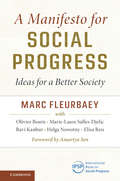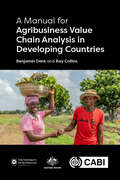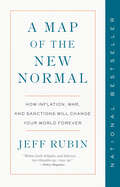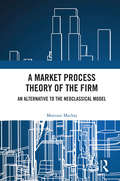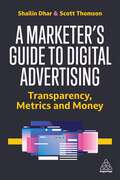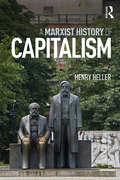- Table View
- List View
A Macroeconomics Reader
by Howard Vane Brian SnowdonA Macroeconomics Reader brings together a collection of key readings in modern macroeconomics. Each article has been carefully chosen to provide the reader with accessible, non-technical, and reflective papers which critically assess important areas and current controversies within modern macroeconomics.The book is divided into six parts, each with a separate introduction highlighting the relevance of the ensuing articles. The areas covered include: Keynes's General Theory, Keynesian economics and the Keynesian revolution; monetarism; rational expectations and new classical macroeconomics; real business cycle approaches: New Keynesian economics: economic growth.This book will be an essential guide for students and lecturers in the field of macroeconomics as well as those interested in the history of economic thought.
A Mad Love: An Introduction to Opera
by Vivien SchweitzerA lively introduction to opera, from the Renaissance to the twenty-first centuryThere are few art forms as visceral and emotional as opera-and few that are as daunting for newcomers. A Mad Love offers a spirited and indispensable tour of opera's eclectic past and present, beginning with Monteverdi's L'Orfeo in 1607, generally considered the first successful opera, through classics like Carmen and La Boheme, and spanning to Brokeback Mountain and The Death of Klinghoffer in recent years. Musician and critic Vivien Schweitzer acquaints readers with the genre's most important composers and some of its most influential performers, recounts its long-standing debates, and explains its essential terminology. Today, opera is everywhere, from the historic houses of major opera companies to movie theaters and public parks to offbeat performance spaces and our earbuds. A Mad Love is an essential book for anyone who wants to appreciate this living, evolving art form in all its richness.
A Magnificent Journey to Excellence: Sixteen Years of Six Sigma at Cummins Inc.
by George K. Strodtbeck III Mohan V. Tatikonda PhDThis book presents a model of organization transformation success. The model framework comprises a series of S-Curves (maturity curves) of planning and execution activities phased over time. The model is illustrated through description and analysis of an actual, two-decade, highly successful, global enterprise transformation Six Sigma program at a Fortune 200 company: Cummins, Inc. Lessons learned from the model and company case study are completely transferrable to other organizational culture, improvement and innovation transformation settings. This insightful book: • Documents a firsthand account of a successful transformation. The authors completely explain what was accomplished and the lessons learned from a 16-year deployment of Six Sigma at Cummins. • Acts as a benchmark for those organizations interested in pursuing primarily a continuous improvement transformation, and more generally for other types of transformation efforts. • Includes substantive interviews with ten key leaders and others who made the transformation possible. • Helps organizations shorten the overall transformation timelines. The documentation of a transformation provides you a model for how to think about organization transformation maturity over time and plan for it. • Recognizes the work of thousands of people involved in transforming a global company. The interviews provide extraordinary perspectives not only by executives who initiated and sustained the transformation program but also by program participants who themselves grew as managers and leaders in their careers through the program. Essentially, this book helps early-career managers and executives see the broader picture of enterprise transformation, especially over time. This helps them be better managers and executives, and importantly, helps them better plan for and hasten their upward career trajectories. Lastly, the book describes a view of possibilities. It describes a clear, sustained success, the steps taken to get there and the measurement of progress. The result provides you with confidence that successful transformation is possible and worth the effort.
A Man and His Mountain: The Everyman who Created Kendall-Jackson and Became America's Greatest Wine Entrepreneur
by Humes9781610392853
A Man for All Markets: Beating the Odds, from Las Vegas to Wall Street
by Edward O. ThorpA New York Times bestseller In a remarkable career, Edward O. Thorp rose up from nothing to become a professor at MIT, invented card counting and the world&’s first wearable computer, beat the casinos of Las Vegas at blackjack and roulette, then became a bestselling author and a hedge fund heavyweight, ushering in a revolution on Wall Street. Now he shares his incredible life story for the first time, revealing how he made his fortune and giving advice to the next generation of investors. An intellectual thrill ride, replete with practical wisdom, A Man for All Markets is a scarcely imaginable tale of ludicrous success.
A Man for All Markets: From Las Vegas to Wall Street, How I Beat the Dealer and the Market
by Nassim Nicholas Taleb Edward O. ThorpThe incredible true story of the card-counting mathematics professor who taught the world how to beat the dealer and, as the first of the great quantitative investors, ushered in a revolution on Wall Street. A child of the Great Depression, legendary mathematician Edward O. Thorp invented card counting, proving the seemingly impossible: that you could beat the dealer at the blackjack table. As a result he launched a gambling renaissance. His remarkable success—and mathematically unassailable method—caused such an uproar that casinos altered the rules of the game to thwart him and the legions he inspired. They barred him from their premises, even put his life in jeopardy. Nonetheless, gambling was forever changed. Thereafter, Thorp shifted his sights to “the biggest casino in the world”: Wall Street. Devising and then deploying mathematical formulas to beat the market, Thorp ushered in the era of quantitative finance we live in today. Along the way, the so-called godfather of the quants played bridge with Warren Buffett, crossed swords with a young Rudy Giuliani, detected the Bernie Madoff scheme, and, to beat the game of roulette, invented, with Claude Shannon, the world’s first wearable computer. Here, for the first time, Thorp tells the story of what he did, how he did it, his passions and motivations, and the curiosity that has always driven him to disregard conventional wisdom and devise game-changing solutions to seemingly insoluble problems. An intellectual thrill ride, replete with practical wisdom that can guide us all in uncertain financial waters, A Man for All Markets is an instant classic—a book that challenges its readers to think logically about a seemingly irrational world.Advance praise for A Man for All Markets“An amazing book by a true icon . . . Edward O. Thorp launched revolutions in Vegas and on Wall Street by turning math into magic, and here he weaves his own life lessons into a page-turner as hot as a deck full of aces. Loved it!”—Ben Mezrich, New York Times bestselling author of Bringing Down the House and The Accidental Billionaires “Whether you are an aspiring professional player, a casual gambler, or an occasional visitor to Las Vegas, you can feel the impact of Edward O. Thorp’s intellect on that desert city. In 1962, Thorp published the classic book Beat the Dealer. The text was based on Thorp’s original research that stemmed from his curiosity about the game of 21 and was billed as a how-to book for the layperson to beat the casinos at blackjack. Simply stated, it changed everything. A Man for All Markets chronicles Thorp’s personal journey in navigating the unexpected and sometimes dangerous obstacles that come along with challenging the status quo of a wealthy corporate adversary.”—Nicholas G. Colon, professional advantage gambler and managing director, Alea Consulting Group “What a CV! Figure out how to win at blackjack using card counting? Check. Build the world’s first wearable computer? Check. Find the formula for valuing financial options but use it to make money rather than win a Nobel Prize? Check. This book is in part the gripping story of how one man’s genius and dedication has solved so many problems in diverse fields. But more important, it’s a fascinating insight into the thought processes of someone with little interest in fame, who has mostly stayed under the radar, yet who has followed his inquisitive mind wherever it has led him, and reaped the resulting rewards. There is nothing more important than knowing how to think clearly. Read this book and learn from a master.”—Paul Wilmott, founder, Wilmott magazine
A Man of the World: My Life at National Geographic
by Gilbert M GrosvenorThe captivating inside story of the man who helmed National Geographic over the course of six decades is a front-row seat to iconic feats of exploration, from the successful hunt for the Titanic to Jane Goodall's field studies, offering a rare portrait of one of the most iconic media empires in history and making an impassioned argument for our enduring need to know and care for our world.Though his career path had been paved by four generations of his family before him, Gilbert M. Grosvenor left his own mark on the National Geographic Society, founded in 1888 and recognised the world over by its ubiquitous yellow border. In an unflinchingly honest memoir as big as the world and all that is in it, Grosvenor shows us what it was like to "grow up Geographic" in a family home where explorers like Robert Peary, Louis Leakey, and Jane Goodall regularly crossed the threshold. As staff photographer, editor in chief and then president of the organisation, Grosvenor oversaw the diversification into television, film, books, as well as its flagship magazine, which under his tenure reached a peak circulation of nearly 11 million. He also narrates the shift from a nonprofit, family-focused enterprise to the more corporate, bottom-line focused world of publishing today.For Grosvenor, running National Geographic wasn&’t just a job. It was a legacy, motivated by a passion not just to leave the world a better place, but to motivate others to do so, too. Filled with world travel, charismatic explorers, and the complexities of running a publishing empire, A MAN OF THE WORLD is the story of one man, a singular family business, and the changing face of American media.
A Man's Reach
by Elmer L. Andersen Lori SturdevantAutobiography of the popular Minnesota Governor in the 1950's.
A Management System for the Seventies (Routledge Library Editions: Management #1)
by John ArgentiOriginally published in 1972. This book was designed to help those in positions of management during the 1970s. The author attempted to predict what problems managers would face during that period, and suggested a practical system of management designed to help them cope with these problems. Many of these suggestions can certainly still be applied to management today. This book is intended for managers in all types of organizations – including those in business, industry, and commerce – as well as students on business and management courses.
A Manager's Guide to BS25999
by Tony DrewittThis book is a concise and practical guide to implementing the new benchmark for business continuity management - BS25999. While the number of events that could potentially disrupt the ability of your organization to continue with its business activities continues to grow, the ramifications are increasingly dramatic. Climate change, terrorism and IT system failure are just some of today's more serious threats - and pressure is growing on all organizations to demonstrate effective, meaningful and dependable emergency preparedness. This guide will help you understand and meet the growing need to demonstrate and provide assurance to partners, customers and stakeholders that, should some significant business disruption occur, you have done everything possible to minimize disruption to the continued supply of the products or services by your organization.
A Manager's Guide to Coaching: Simple and Effective Ways to Get the Best From Your People
by Brian Emerson Anne LoehrTo stay on top, companies need to do more than just tread water—they need to grow. And that means that their employees need to develop and improve their skills at the same pace. More than ever, managers are being encouraged to improve employee performance through effective coaching, but so few of them have the time—or the knowledge—it takes to do it successfully. Brian Emerson and Ann Loehr have spent years showing some of the country’s top companies how to develop their most promising employees. Now in this helpful manual they guide managers through every step of the coaching process, from problem solving to developing accountability. Readers will discover:the top 10 tips every manager should know before he starts to coach • how to handle difficult conversations, conflicting priorities, and problem team members • how to hold follow-up meetings after goals and priorities have been set • sample questions they can adapt to various situations • examples of common problems and how they can use coaching to address them.Clear, practical and straightforward, this is an invaluable tool that will help all leaders coach employees, colleagues, and themselves to excellence.
A Manager's Guide to Human Behavior, Fifth Edition
by Matthew Reis Judith GellerUnderstanding how and why employees behave as they do is a critical skill for managers in every organization. Managers are responsible for ensuring that the organization’s mission and strategic goals are enacted, so it is of the utmost importance they know how motivate and engage employees. This updated and revised edition of A Manager’s Guide to Human Behavior will prepare managers to better understand, motivate, and focus the energies of individual employees and the collective energy of their work teams. Building on the content in the fourth edition, this updated course reexamines key theories and focuses on their practical application to typical management situations. New topics is this edition include learning organizations and open systems, as a context for understanding how individuals contribute to organizational effectiveness; self-awareness; Goleman’s emotional intelligence; and Bridge’s transitions model of change. The performance management section has been enhanced with a simplified process model (define, develop, review and reward), and the section on leadership examines the concept of the versatile leader who engages the spirit, head, heart, and hands of employees. Throughout the course, self-assessments, worksheets, checklists, and questionnaires give students the opportunity to apply what they are learning. Each chapter incorporates an action plan tied to the objectives and competencies for the topic area. Short case studies enable students to apply their new knowledge to analyze, understand, and influence human behavior.
A Manager's Guide to ISO22301
by Tony DrewittHave you ever wondered whether your business continuity plan is any good, or whether youve even got a business continuity plan? Anyone can write a simple document, call it a business continuity plan and hope for the best. But, unless you know that it will do what it is supposed to, it may be a wasted investment. This practical guide to the ISO22301 business continuity management system standard shows you how to develop and implement a business continuity management (BCM) and disaster recovery plan; ensuring you get back on your feet with the minimum of fuss, should the unthinkable happen. Providing a comprehensive introduction to the topic, this book includes practical, detailed guidance on developing and implementing a BCM system certifiable to the ISO22301 standard, using detailed and illustrative examples. A BCM policy and other useful document templates are provided in the appendices. As an international standard, ISO22301 is likely to become the benchmark that is used to judge how a business will cope with disaster. Although only some public bodies are required by law to have business continuity plans, an ISO22301 compliant system will give you peace of mind, reassure your customers and business partners and help you to meet your legal obligations. Disaster can strike without warning, so the time to start developing an ISO22301 compliant system is now. This book is the perfect place to start. Tony Drewitt has specialised in operational risk management and business continuity since 2001 and is currently working with several organisations to develop management systems in line with ISO22301 and its predecessor BS25999. He has written several books on business continuity including BS25999: A Pocket Guide, A Managers Guide to BS25999 and Everything You Want to Know About Business Continuity.
A Manager's Guide to PR Projects: A Practical Approach (Lea's Communication Ser.)
by Patricia ParsonsA Manager's Guide to PR Projects, Second Edition picks up where classic public relations textbooks leave off. It provides hands-on guidance in planning the preliminary research for a public relations project and creating a plan to achieve specific goals, guiding the reader through managing the project's implementation. It contains worksheets that can be used for a visual representation of the planning process for both student edification and presentation to clients. The book is designed as a user-friendly guide to take the reader through the four-step public relations planning process from a number of vantage points. Intended as a learning tool for use in both the class and beyond, this book's approaches are based on real experiences in the management of communications projects designed to meet organizational goals through achieving public relations objectives. This fully revised second edition offers PR students and practitioners new material that includes the following: The impact of social media on each phase of the planning process. Digital approaches to strategic and summative research, message dissemination and public engagement. Strategies to enhance accountability. Ethics considerations in the planning process. Updated print and web-based resources for PR managers.
A Manager's Guide to Sexual Orientation in the Workplace
by Bob Powers Alan EllisFor the first time ever, managers will have a tool that will enable them to effectively grapple with the controversial, and sometimes explosive issues surrounding sexual orientation. Cultivated from Bob Power's 25 years business experience with some of the world's finest organizations, A Manager's Guide to Sexual Orientation in the Workplace provides managers with the knowledge, skills and resources to foster higher productivity and performance through an all-inclusive work environment.
A Manager's Guide to Virtual Teams
by Yael ZofiYael Zofi&’s proprietary Trust Wheel model is a proven solution to the unique challenges managers must overcome as more people migrate to partially or fully-remote working situations.Based on the author&’s twenty-plus years of consulting experience, this powerful tool encourages cohesiveness and engagement among team members--even if they&’ve never met. A Manager&’s Guide to Virtual Teams does this by providing a practical road map for bridging the physical distance among coworkers, incorporating self-study exercises and simple, fun activities that develop trust and ensure your team&’s success.The book explores the most critical elements to success for a team founded in trust, including:accountability,communication,conflict management,and deliverables.Complete with examples, case scenarios, and strategies to help you navigate even your biggest hurdles, A Manager&’s Guide to Virtual Teams will help your disparate collection of people get their work &“out the door&” faster and better.
A Manager's Guide to the New World of Work: The Most Effective Strategies for Managing People, Teams, and Organizations (The Digital Future of Management)
by MIT Sloan Management ReviewThe best tools and insights to succesfully navigate the novel challenges of the digital workplace.How can technology and analytics help companies manage people? Why do teams working remotely still need leaders? When should organizations use digital assessment tools for gauging talent and potential? This book from MIT Sloan Management Review answers questions managers are only beginning to ask, presenting insights and stories from organizations navigating the novel challenges of the digital workplace. Experts from business and academia describe what's worked, what's failed, and what they've learned in the new world of work, looking at strategies that organizations use to help managers and employees adapt to the fast-changing digital environment.
A Manifesto for Social Progress: Ideas For A Better Society
by Helga Nowotny Ravi Kanbur Marc Fleurbaey Elisa Reis Olivier Bouin Salles-Djelic Marie-LaureAt this time when many have lost hope amidst conflicts, terrorism, environmental destruction, economic inequality and the breakdown of democracy, this beautifully written book outlines how to rethink and reform our key institutions - markets, corporations, welfare policies, democratic processes and transnational governance - to create better societies based on core principles of human dignity, sustainability, and justice. This new vision is based on the findings of over 300 social scientists involved in the collaborative, interdisciplinary International Panel on Social Progress. Relying on state-of-the-art scholarship, these social scientists reviewed the desirability and possibility of all relevant forms of long-term social change, explored current challenges, and synthesized their knowledge on the principles, possibilities, and methods for improving the main institutions of modern societies. Their common finding is that a better society is indeed possible, its contours can be broadly described, and all we need is to gather forces toward realizing this vision.
A Manual for Agribusiness Value Chain Analysis in Developing Countries
by Dr Benjamin Dent Professor Ray CollinsValue Chain Analysis (VCA) diagnoses the current state of a value chain and makes recommendations to improve its effectiveness and efficiency. Applying VCA in developing countries is very often subject to limited time and funding. This manual shows how VCA principles can be applied under such circumstances. It explains how to undertake an affordable VCA that still generates valid data and so produces recommendations that will have impact. The manual has four parts: Part 1: Our Approach to Value Chain Thinking - sets out the principles and practice of taking a value chain approach. Part 2: Conducting Value Chain Analysis - covers planning a VCA, conducting consumer research, interviewing, analysing, creating recommendations and reporting. Part 3: Case Studies - illustrates successful VCAs with case studies e.g. Ghanaian pineapples and Kenyan indigenous chicken. Part 4: Further Reading and Biographies The practical style and content will make this manual accessible to a wide audience: NGO practitioners; government policymakers and extension officers; private sector managers and consultants; and academics for teaching and researching.
A Map of the New Normal: How Inflation, War, and Sanctions Will Change Your World Forever
by Jeff RubinNATIONAL BESTSELLERBestselling economist Jeff Rubin warns that the shock inflation of 2021 is the front of a perfect storm of war, supply-chain disruption, geopolitical realignment, domestic upheaval, and energy scarcity that will change everything.During the pandemic, government deficits skyrocketed to record highs while central banks primed the printing presses—and the time has come to pay for it. The ramifications of international COVID-19 spending could potentially last for decades, and inevitably one of the first consequences will be that central banks will lose control of interest rates, and subsequently, growth and inflation targets. The genie will be out of the bottle.That is just the first symptom of a series of cascading upheavals. Supply-chain disruptions have already shown the vulnerability of the globalist model that has fueled growth for the past decades. War has not only shown the fragility of the status quo, but has revealed diplomatic and economic rifts that promise to shift trading patterns. At the same time, the precarity of the US dollar underlines the life-or-death importance of foreign markets and resources, energy in particular. And consolidation of a Eurasian bloc, from Russia to China, and encompassing old enemies like Iran and former US ally Saudi Arabia, hint that the upheaval of COVID-19 was just the beginning.Tracking trade wars and kinetic wars, central banks and runs on banks, pipelines blown up and startups knocked down, A Map of the New Normal gives us a glimpse of a near future that will look very different from the recent past. It reminds us that our mortgage rates and job security, our grocery bills and investments, are all tied to events set in motion by governments, corporations, and black swans around the world.
A Map of the New Normal: How Inflation, War, and Sanctions Will Change Your World Forever
by Jeff RubinNATIONAL BESTSELLERBestselling economist Jeff Rubin warns that the shock inflation of 2021 is the front of a perfect storm of war, supply-chain disruption, geopolitical realignment, domestic upheaval, and energy scarcity that will change everything.During the pandemic, government deficits skyrocketed to record highs while central banks primed the printing presses—and the time has come to pay for it. The ramifications of international COVID-19 spending could potentially last for decades, and inevitably one of the first consequences will be that central banks will lose control of interest rates, and subsequently, growth and inflation targets. The genie will be out of the bottle.That is just the first symptom of a series of cascading upheavals. Supply-chain disruptions have already shown the vulnerability of the globalist model that has fueled growth for the past decades. War has not only shown the fragility of the status quo, but has revealed diplomatic and economic rifts that promise to shift trading patterns. At the same time, the precarity of the US dollar underlines the life-or-death importance of foreign markets and resources, energy in particular. And consolidation of a Eurasian bloc, from Russia to China, and encompassing old enemies like Iran and former US ally Saudi Arabia, hint that the upheaval of COVID-19 was just the beginning.Tracking trade wars and kinetic wars, central banks and runs on banks, pipelines blown up and startups knocked down, A Map of the New Normal gives us a glimpse of a near future that will look very different from the recent past. It reminds us that our mortgage rates and job security, our grocery bills and investments, are all tied to events set in motion by governments, corporations, and black swans around the world.
A Market Process Theory of the Firm: An Alternative to the Neoclassical Model (Routledge Studies in the Economics of Business and Industry)
by Mateusz MachajNeoclassical economics has been criticized from various angles by orthodox schools. The same can be said about its particular branch: the theory of the firm. This book demonstrates how a successful theory of the firm can be presented without flawed notions of a neoclassical framework and used to comprehend actual business history. The author argues that we should start from the assumption that businesses are inevitably imponderable, as that is their nature, in the process of economic evolution. The book offers an in-depth exploration of neoclassical limitations by examining each of the small details associated with the famous MR = MC rule. It follows a step-by-step approach, which starts off with neoclassical assumptions and then moves into more empirically sound theory, based on modeling logic and rooted in real world examples. The author presents a novel discussion on the size of the firm, both in terms of classifying a firm’s expansion and about the factors that limit the size of the firm and argues how formal pricing theory can be built using more indeterminate assumptions about firms. Further, there is a discussion on how firms are rooted in amorphous industries, which helps to explain economic progress better by emphasizing the importance of economic experiments, mistakes and bankruptcies. This is a valuable reference for scholars and researchers who are interested in a range of topics from microeconomics, through pricing theory to industrial organization, history of economic thought and managerial economics.
A Marketer's Guide to Digital Advertising: Transparency, Metrics, and Money
by Shailin Dhar Scott ThomsonHow can individual marketers and their teams navigate the complex issues that seem to overwhelm the digital advertising industry today? They can learn about the metrics worth using, the importance of measurement and the technology available. With contradictory rules surrounding data privacy, measurement constraints, changes to supply chains and other complexities often too difficult to approach, the world of marketing is more complex than ever before. A Marketer's Guide to Digital Advertising helps marketers navigate the complicated world of digital advertising by diving into the metrics, money and technology fueling the marketing industry. Digital advertising consultants Shailin Dhar and Scott Thomson outline the forces shaping the current digital landscape and the common responses from advertisers trying to design their digital strategy. Walking readers through the common missteps made within digital advertising, they provide useful insight into measurement and thoughtful alternatives to practices often found lower on a company's priorities list. A Marketer's Guide to Digital Advertising offers ways to minimize waste and improve outcomes for brands and their business partners. The book illuminates the gap between in-house marketing teams, agency professionals and tech partners whilst helping readers make sense of the way money flows through the global ad industry.
A Marxist History of Capitalism
by Henry HellerHenry Heller’s short account of the history of capitalism combines Marx’s economic and political thought with contemporary scholarship to shed light on the current capitalist crisis. It argues that capitalism is an evolving mode of production that has now outgrown its institutional and political limits. The book provides an overview of the different historical stages of capitalism, underpinned by accessible discussions of its theoretical foundations. Heller shows that capitalism has always been a double-edged sword, on one hand advancing humanity, and on the other harming traditional societies and our natural environment. He makes the case that capitalism has now become self-destructive, and that our current era of neoliberalism may trigger a transition to a democratic and ecologically aware form of socialism.
